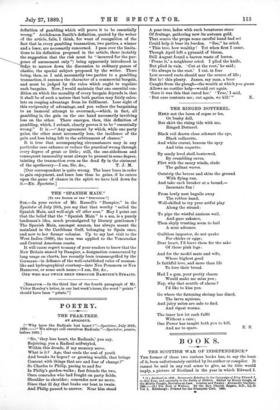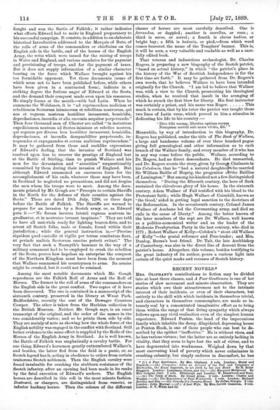BOOKS.
THE SCOTTISH WAR OF INDEPENDENCE.* THE former of these two curious books has, to say the least of it, been unfortunately entitled by its author or compiler. It cannot be said in any real sense to give, as its title would imply, a picture of Scotland in the year in which Edward I.
• (L) Scotland in 1298: Documents Relating to the Campaign of King Edward /1, in that /ear. and especially to the Battle of Falkirk Edited by Henry Gough, ot the Middle Temple, Barrister-at-Law. London and Paisley : Alexander Gardner. 1828.—p.) The Book of Wallace. By the Rey. Charles Rogers, DX., LL.D. Vol L Edinburgh; Printed for the Cirampiem Club. 1882. fought and won the Battle of Falkirk; it rather indicates what efforts Edward had to make in England preparatory to his successful campaign. It consists, in addition to an elaborate historical Introduction addressed to the Marquis of Bute, of the rolls of arms of the commanders or chieftains on the English side in the battle, and of the horses of the English Army, the writs which were issued for the raising of troops in Wales and England, and various mandates for the payment and provisioning of troops, and for the payment of taxes. But it does not supply information of a similar character bearing on the force which Wallace brought against his too formidable opponent. Yet these documents (some of which seem not to have been published before, while others have been given in a contracted form), indicate in a striking degree the furious anger of Edward at the Scots, and the demand their conquest made even upon his resources. He simply foams at the mouth—with bad Latin. When he summons the Welshmen, it is "ad reprimendam maliciam et rebellionena Seotorum inimieorum et rebellium nostrorum, qui nos et regnum nostrum hostiliter invasernnt, homicidia, depredaciones, incendia et alia enormia nequiter perpetrando." Then four thousand men of Chester are called "in instantem expedicionem nostrum ad Scotos inimicos et rebelles nostros, qui regnum per diversa loca hostiliter invasernnt, homicidia, depredaciones, et incendia dampnabiliter perpetrando, in- sequendos et expugnandos et comm maliciam reprimendam." It may be gathered from these and suchlike expressions of Edward's feeling, that the invasion of Scotland was resolved upon less to recover the prestige of England lost at the Battle of Stirling, than to punish Wallace and his men for the devastation and " atrocities " unquestionably committed by them during their invasion of England. But although Edward summoned an enormous force for the accomplishment of his ends, whatever these may have been, in Scotland he neglected no precautions, and did not despise the men whom his troops were to meet. Among the docu- ments printed by Mr. Gough are "Precepts to certain Sheriffs in the North for the defence of their counties against the Scots." These are dated 19th July, 1298, or three days before the Battle of Falkirk. The Sheriffs are warned to prepare for an invasion by a Scotch army, or, as Edward puts it :—" Ne forsan incursu latenti regnum nostrum in- grediantur, et in nostrates irrnant inopinate." They are told to have all materials ready for lighting beacon-fires, and to arrest all Scotch folks, male or female, found within their jurisdiction ; while the general instruction is,—" Proviso siquidem quod custodie et vigilie per totnm comitatum fiant, ut perinde malicia Scotorum caucius potent evitari." The very fact that such a Nasmyth's hammer in the way of a military armament had to be employed to crush the rebellion of the Scots, proves how hopeless an enterprise the conquest of the Northern Kingdom must have been from the moment that Wallace summoned his countrymen to arms. Its armies might be crushed, but it could not be retained.
Among the most notable documents which Mr. Gough reproduces are the Falkirk Roll of Arms and the Roll of Horses. The former is the roll of arms of the commanders on the English side in the great conflict. Two copies of it have been discovered. The one is contained in a manuscript of the sixteenth century, preserved in the library at Wrest Park, Bedfordshire, recently the seat of the Dowager Countess Cowper. The other is taken from the Harleian collection in the British Museum. Neither, Mr. Gough says, is an exact transcript of the original, and the order of the names in the two considerably varies; and so he prints them side by side. They are mainly of note as showing how the whole force of the English nobility was engaged in the conflict with Scotland. Still better evidence to the same effect is supplied by the Rolls of the Horses of the English Army in Scotland. As is well known, the Battle of Falkirk was emphatically a cavalry battle. For one thing, Edward's horsemen greatly outnumbered Wallace's, and besides, the latter fled from the field in a panic, or, as Scotch legend has it, acting in obedience to orders from certain traitorous Scotch noblemen. Then the English cavalry were found invaluable for crushing the stubborn resistance of the Scotch infantry, after an opening had been made in its ranks by the fatal execution of Edward's archers. The English horses are described in this roll in the most minute fashion. Deo:trail-Li, or chargers, are distinguished from rwaeitti, or inferior hackney horses. Then the colours of the different .... classes of horses are most carefully described. One is ferrandue, or dappled; another is mcreellus, or roan ; a third is eorus, or sorrel ; a fourth is claru,s badius, or bright bay; a fifth is baiizain, or pied,—from which word comes bauseant, the name of the Templars' banner This is, it will be seen, a very valuable and readable as well as a care- fully edited book.
That veteran and industrious arclueologist, Dr. Charles Rogers, is preparing a new biography of the Scotch patriot, "based on actual history," in which "the patriot's place in the history of the War of Scottish Independence is for the first time set forth." It may be gathered from Dr. Rogers's own words, that he believes Wallace to have been intended originally for the Church. "I am led to believe that Walla,* was, with a view to the Church, prosecuting his theological studies, when he received that insult in the avenging of which he struck the first blow for liberty. His first instructor was certainly a priest, and his name was Roger This much is certain, that by his tutor the patriot was taught these two lines of Latin verse, which proved to him a stimulus in dedicating his life to his country :—
'Dice tibi verum, libertas optima rernm
Nunquam serval sub neicu vivito, flu.'"
Meanwhile, by way of introduction to this biography, Dr. Rogers has published, under the title of The Book of Wallace, a large and handsome volume of over three hundred pages, giving full genealogical and other information as to each branch of the Wallace family, and every member of it who has in any way come before the public. Wallare, according to Dr. Rogers, had no direct descendants. He died unmarried, Tv and Dr. Rogers scouts the story, given by Geor . Chalmers in his Caledonia, that he "had a natural daughte ho married Sir William Baillie of Hoprig, the progenitor o ethe Baillies of Lamington." But among his kindred not a few distinguished themselves. "During the fifteenth century, the hero of Sark sustained the chivalrous glory of his house. In the sixteenth century, Adam Wallace of Fail testified with his blood to the Protestant faith ; while Hugh Wallace of Cairnhill, known as 'the Good,' aided in getting legal sanction to the doctrines of the Reformation. In the seventeenth century, Colonel James Wallace of Auchans led the Covenanting army, and died an exile in the cause of liberty." Among the better known of the later members of the sept are Dr. Wallace, well known as a politico-economical writer and as the leader of the Moderate Presbyterian Party in the last century, who died in 1771; Robert Wallace of Kelly—Cobden's "stout old Wallace of Kelly "—the postal reformer and Free-trader; and Mrs. Dunlop, Burns'a best friend. Dr. Tait, the late Archbishop of Canterbury, was also in the direct line of descent from the patriot's house. Altogether, this volume, besides testifying to the great industry of its author, pours a curious light into certain of the quiet nooks and recesses of Scotch history.



































 Previous page
Previous page